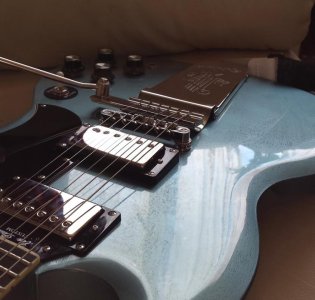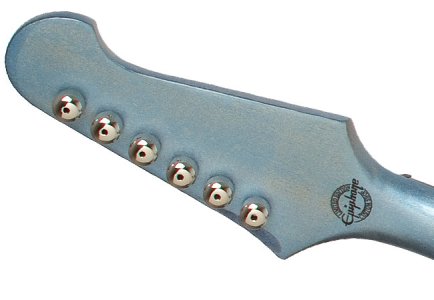zenmindbeginner
New member
Re: TV Pelham Blue: The Secrets Revealed
So do you think they filled some of the grain the way Gibson did it by using light dry coats of primer? The pores are clearly filled with something that's white. It would be easier to just fill the grain with filler and remove some of it to get that effect.
I'm sure that you can get the same doghair effect using water based stain and oil based grain filler without putting the grain filler on top of the stain. Grain filler likes to be lightly sanded after it's applied... so I just see grain filling over color as problematic unless you seal in the color with some barrier coats of lacquer and even that can be sanded through.
If I was going to do the doghair finish, I would simply use oil based white grain filler and water based trans-black stain. With water as it's carrier, the black stain won't dye the white oil based filler and you'll get the exact same effect.
Putting on grain filler is probably the crappiest part of finishing mahogany... it's no fun and putting it over stain would make a difficult no-fun process more difficult and even less fun IMHO.
I'd love to see more interesting combinations of contrasting pore filed finishes... lots more interesting combinations than black and white although that is the punchiest visually.
Really love what you are doing here, it's going to turn out spectacular with all of these tests you are performing! I mean... practicing on scrap is a GENIUS move.
As for grain filler on top of color, here's how it looks on Collings' Doghair finish:
View attachment 63127
Much more pronounced than the Epiphone, though *some* of that is likely the stronger contrast between black and white than blue and white. Also, Collings uses a stain for color on that finish, not lacquer. Someone more skilled than me might be able to get filler into the pores on top of Pelham Blue (and maybe even do it without destroying the sparkle) but, at least with the tools I have at my disposal, I cannot. But I'm increasingly convinced, based on what I'm seeing firsthand, that Epi didn't do theirs that way. In fact, I don't think they used filler at all.
So do you think they filled some of the grain the way Gibson did it by using light dry coats of primer? The pores are clearly filled with something that's white. It would be easier to just fill the grain with filler and remove some of it to get that effect.
I'm sure that you can get the same doghair effect using water based stain and oil based grain filler without putting the grain filler on top of the stain. Grain filler likes to be lightly sanded after it's applied... so I just see grain filling over color as problematic unless you seal in the color with some barrier coats of lacquer and even that can be sanded through.
If I was going to do the doghair finish, I would simply use oil based white grain filler and water based trans-black stain. With water as it's carrier, the black stain won't dye the white oil based filler and you'll get the exact same effect.
Putting on grain filler is probably the crappiest part of finishing mahogany... it's no fun and putting it over stain would make a difficult no-fun process more difficult and even less fun IMHO.
I'd love to see more interesting combinations of contrasting pore filed finishes... lots more interesting combinations than black and white although that is the punchiest visually.
Really love what you are doing here, it's going to turn out spectacular with all of these tests you are performing! I mean... practicing on scrap is a GENIUS move.


